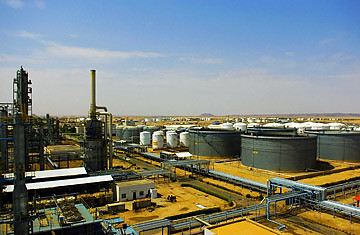
Sudan oil refinery where the newly-emerging oil-rich central African state has been under fire from U.S. imperialism for years. The leadership of the country is being hounded by the ICC which it is not a party to the Rome Statute., a photo by Pan-African News Wire File Photos on Flickr.
S Sudan oil stoppage drives up prices
By Javier Blas, Commodities Editor
Financial Times
Investors trying to understand why oil prices are so high have so long been focused on Iran. But rather than looking at supply disruptions stemming from the Strait of Hormuz, they need to turn their eyes to South Sudan.
The African country, which won independence from its northern neighbour last year, was until last month pumping about 260,000 barrels of crude a day, according to the International Energy Agency. But on January 25 the authorities in Juba, the capital, ordered a complete shutdown due to a disagreement with Sudan about pipeline fees.
The oil of South Sudan is far more important that it appears at first glance. The country supplied a mere 0.3 per cent of global production last year, but the headline figure is deceptive. South Sudan produces a particular kind of crude sought by Asian importers due to its low sulphur and high waxy content.
The loss could not have come at a worse time as the demand for the African nation’s two crude oil export grades – known as Dar Blend and Nile Blend – is stronger than ever this year due to power shortages in Japan, which are forcing utilities to burn unrefined crude, and a strong fuel oil market in the Asia-Pacific region.
The loss of South Sudanese oil has forced China and Japan, traditionally big consumers of the country’s oil, to shop elsewhere, pushing up the premiums of the physical market.
China has embarked on a shopping spree in west Africa, securing cargoes of heavy, low sulphur Angolan oil and, in the process, has driven up prices. Japan, meanwhile, has bought cargoes of Vietnam’s Su Tu Den crude, pushing its premium over Brent to a record high.
Worse, the market is bracing itself for a long-lasting disruption.
South Sudan has started to inject fresh water into the 1,600-km pipeline that links the fields, near the border between South Sudan and Sudan, to the export terminal in Port Sudan to ensure the heavy, waxy oil does not clog the line. The measure involves pumping 2.8m barrels of water to fill the line and remove the oil – enough to fill about 180 Olympic-sized swimming pools – and signals a long stoppage, say traders.
Oil traders involved in South Sudanese crude say the country would need between three and months to restart production, at a cost of $300m. The IEA is forecasting that the country’s production would not recover its pre-crisis level until at least the fourth quarter of the year, forcing China and Japan to fight for low sulphur barrels elsewhere, and driving up prices.
But the damage could be prolonged. Traders fear a more lasting disruption, with South Sudan production running at zero for the remainder of the year.
No comments:
Post a Comment